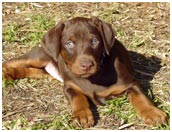
“only in the spirit of love, sacrifice and great cost will we bring our breed to a state of genetic excellence”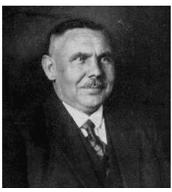 Philipp Grünig
Philipp Grünig
“Judge, scientific breeder and profound student of the Dobermann”


“only in the spirit of love, sacrifice and great cost will we bring our breed to a state of genetic excellence” Philipp Grünig
Philipp Grünig
“Judge, scientific breeder and profound student of the Dobermann”
By Philipp Grünig – Judge, breeder and profound student of the Dobermann (first published in 1932).
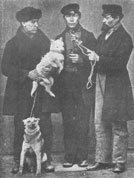 |
|
| Herr Dobermann (left) with Schnuppe (seated) |
Herr Karl Friedrich Louis Dobermann (1834-1891) was a tax collector & dogcatcher /skinner for the state of Thüringia, Germany and had a second job as night watchman. As a dogcatcher, he could choose the best dogs for his purpose. He was concerned with character rather than conformation. His requirement was to create a watchful, sharp, brave and intelligent dog. He wanted a guard dog with a strong mouth, a good nose, courage, hardness and a highly developed protective instinct. We know he succeeded. From the beginning, his dogs were known regionally as "Dobermann's Hunde". They gained a solid reputation for harsh strength of character and an ability to hunt, bite and kill vermin. Herr Dobermann crossed several types of dogs but did not keep records (there were no pure bred dogs at that time) and there is little agreement on the origins of the Dobermann.
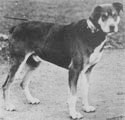 |
|
| Butcher Dog |
Herr Dobermann's son tells us his father had a clever and fearless dog named "Schunpp" who he later mated with a very keen protection bitch named Bismark (later called Bisart). Bisart's puppy's were black with rust markings. One named "Pinko" had a natural bob tail and produced some blue puppies. Otto Göller, a later breeder who knew Herr Dobermann, claimed the foundation was a mongrel named "Schnuppe" (a grey smooth coated dog seated in the photo above) mated to a Butchers dog. Göller later claimed the German Shepherd dog, short haired gun dog, the Dane and the German Pinscher played a role.
A German dog magazine article dated 1898 states "At the end of the 1860's, the owner of a gravel pit at Apolda called Dietsch had a blue-grey bitch, a sort of Pinscher which he mated with a black butcher's dog. The sire already had the characteristic tan markings and was a cross between a sheep dog and a butcher's dog. Herr Dobermann, a skinner who unfortunately died too early, crossed the issue of these two dogs, which became good guard dogs, with German Pinschers. That is the origin of today's Dobermann".
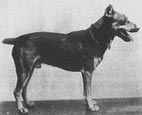 |
|
| German Pinscher |
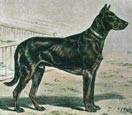 |
|
| Beauceron |
In 1901, Richard Strebel (German authority on canine matters) wrote "It is doubtful if the Dobermann Pinscher is a true Pinscher, it should probably be classified more as a sheep dog". In 1933 the German Dobermann club investigated the origins of the breed and decided the main ancestor was the German Pinscher. But in 1947 Herr Grünig wrote the Dobermann probably descended more from the Beauceron because the German Pinscher is not similar body structure or behaviour and it would not be possible to raise the average shoulder height from 40 to 70cm in only thirty years.
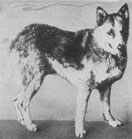 |
|
| Thüringen Shepherd |
However "Dobermann like" dogs (referred to as the "Thüringen breed") were around Apolda before Herr Dobermann began breeding and these were created by crossing German Pinchers and Sheepdogs. Beaucerons are known to be in Apolda in those days and it is also possible they were ancestors of the Butchers dogs. The Butchers dogs were not purebred. Some early Dobermann closely resembled Butchers dogs and some resembled Rottweilers.
Max Kuensler wrote in 1925 that the sheep dog, the Weimeraner and the German Pinscher were involved but certainly no Rottweillers or Terriers were known in Apolda at that time. Most agree the Thüringen Shepherd (sheepdog), Butchers Dog, German Pincher & Beauceron were available and some experts include the black and tan terrier. Interestingly, the best authorities on the Rottweiler confirm that so called Butchers dogs were their common ancestor.
Initially the guarding qualities and keeness on game posed some hindrance to the breed's popularity but, in 1863 (when he was 29 years old) Herr Dobermann presented his "Dobermann Pinschers" on the first dog market in Apolda Germany with great success. This event became so important that it is officially recorded in the history of the city of Apolda.
It is known that, after Herr Dobermann died, both the Manchester Terrier and the Greyhound were introduced into the Dobermann breed.
 |
|
| Otto Göller |
 |
|
| Goswin Tischler |
In 1890 the Standard for the breed was written and approved by the German Kennel Club and remains basically the same - although judges today are accepting much larger Dobermann than the standard calls for.
Around the time of Herr Dobermann's death in 1891, came the Breeders: Goswin Tischler and Otto Göller, who were very influential in the development of the Dobermann breed. Otto Göller was the founder of the National Dobermann Pinscher Club in 1899.
| 1893 | The oldest Dobermann to be entered in German stud books, as parent stock, are Bosco and Caesi whelped in 1893 and 1894 respectively. They were the parents of the Sieger Prinz Matzi v. Grönland, born in 1895, registration number DZ7 but, after 3 years, there is no record of Matzi's progeny. | |
| 1896 | Fortunately brought the rise of the Dobermann from Thüringen and these were the germ cell of the breed today. These were called Lux, Schnupp, Landgraf & Rambo. The bitches were Tilly I (later v. Grönland, NZDB17), Helmtrude, Hertha and Elly. |
 |
 |
 |
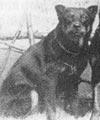 |
 |
| 1897 Alarich v. Thüringen |
1898 Gerhilde NZDB 2 |
1898 Graf Belling v. Grönland (later v. Thüringen) NZDB 1 |
1898 Prinzessin Schlippche NZDB 12 |
1899 Prinz Strick NZDB 12 |
| 1897 | Out of Rambo & Elly came Junker Slenz v. Thüringen owned by the Frankfort Dobermann club and sire to many excellent dogs. Another great producer in this year was Alarich v. Thüringen (photo above) , (no registration number) known for his incredible sharpness. | |
| 1898 | Goswin Tischler bred Lux and Tilly I under the Grönland Kennel name, to produce a very famous "5 Star" litter of outstanding quality. These were Greif, Tilly II, Krone, Lottchen v. Thüringen and Graf Belling v. Thüringen (also known as Graff Belling v. Grönland) (photo above) the first Dobermann registered in the NZ stud book. | |
| 1899 | Brought Lady v. Ilm-Athen who had the blood of an English (Manchester) Terrier in her. | |
| 1900 | This year was marked by the stud book entry requirement of every breeding animal. |
Note on Registration Entries:
"DZ" referred to registration with The Dobermannpinscher Club of Hamburg, The Dobermannpinscher Verein and The Dobermannpinscher Verband.
"NZ" refers to the National Dobermannpinscher Stud Book - published by the oldest German Dobermann organization - the National Dobermannpinscher Verein.
No prescribed rules or methods of procedure for correct breeding existed in the early days of the breed so pedigrees were not verified.
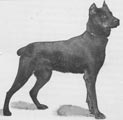 |
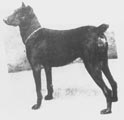 |
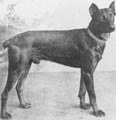 |
 |
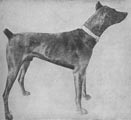 |
| 1901 Graf Wedigo v. Thüringen NZ 74 |
1901 Veronica v. Thüringen NZ 65 |
1903 Weddo v. Thüringen NZ 133 |
1904 Hellegraf v. Thüringen NZ 219 |
1905 Primus v. Thüringen NZ 313 |
| 1901 | Through her son, Prinz v. Ilm-Athen, Lady v. Ilm-Athen advanced the cause of the Dobermann. Prinz was one of the greatest breeding dogs of all time with outstanding hereditary powers to produce dark markings and sharpness. He can be found in the 5 generation pedigrees of the greatest breeding and show dogs into the 1930's. Five main (blood) lines descended from him. Lady v. Calenberg (not registered) was another bitch of part or full blooded Manchester Terrier and her entire progeny were known for admirable smooth, short hair and sharpness towards everything predatorily inclined. Her immense influence over the breed was through her son, Tell v. Kirchweyhe and his sons, Hans v. Aprath and Fedor v. Aprath. This year brought many good dogs including Veronica v. Thüringen (photo above), best known for her descendants and Graf Wedigo v. Thüringen (photo above). | |
| 1903 | Brought 5 excellent bitches and 6 new stud dogs including the brown Hans v. Thüringen from South Germany, the intensely black Weddo v. Thüringen (photo above) (grandsire to Lord v. Ried-1907) and Tell v. Kirchweyhe (not registered son of Manchester Terrier blooded Lady v. Calenberg) from North Germany. | |
| 1904 | Of the many good dogs that year, Grünig says through Helligraf v. Thüringen (photo above) the entire breed took on a new face and stature. As a stud dog, he combined and transmitted his own qualities with the best ancestral background. He was a brown male with genuine "Adel", beauty, perfection and power. Ten main Dobermann lines radiate from him. | |
| 1905 | Brought the excellent black bitches Cordula v. Thüringen (Helligraf daughter) and Jenny v. Deutz (blue) and the black male, Primus v. Thüringen (photo above). |
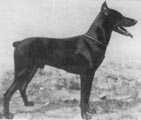 |
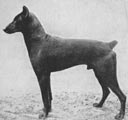 |
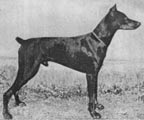 |
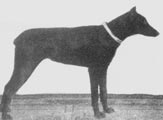 |
| 1906 Fedor v. Aprath NZ 244 |
1908 Marko v. Lützellinden (later v. Jägerhof) DZ 637 |
1909 Prinz Modern v. Ilm-Athen NZ 885 |
1909 Sybille (later v. Langen-Silberberg) DZ 705 |
| 1906 | Marked the beginning of a trend to more refinement of form, darker, richer markings, stabilized size and somewhat less fearsome sharpness. Of six males valued for their beauty, two had the power to transmit: Sturmfried v. Ilm-Athen (allegedly from Manchester Terrier grandmother) and Fedor v. Aprath (brown male (photo above)) was sharp character and transmitted outstanding head type. Fedor's sire was not registered and his dam was Lady v. Calenberg, also of terrier blood. |
|
| 1907 | Lord v. Ried had "Adel", elegance and imposing size, appearance and great hereditary value. He was a German Sieger. A dozen main (blood) lines descended from him and he could also be found in the greatest breeding and show dogs into the 1930's. | |
| 1908 | Marco v. Jägerhof (photo above) was the embodiment of elegance but transmitted his worse traits (incomprehensible cowardice) along with his best. | |
| 1909 | According to Grünig, this year was the most fruitful to date for the breed. Prinz Modern v. Ilm-Athen (photo above) was a popular stud dog due to his conformation but unfortunately also transmitted his lack of courage. Part of his success was due to residing in Düsseldorf, then the centre of the breed's growth and activity. At least a dozen main blood lines radiate from him and survived to this day. The black male, Moritz v. Burgwall projected 5 main blood lines into the future. One of many valuable bitches, born that year, was Edle v. Ilm-Athen who combined beauty and hereditary worth. Sybille (later v. Langen-Silberberg) (photo above) was a black bitch with typical greyhound expression and little temperament. Her dam "Stella" was the daughter of a black greyhound sire. |
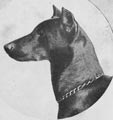 |
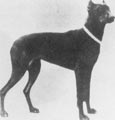 |
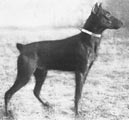 |
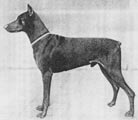 |
| 1910 Adelfried v.d. Wendenburg DZ 1377 |
1911 Heidi v. Silberberg DZ 1606 |
1912 Prinz Bodo v. Hörnsheim DZ 3106 |
1913 Edelblut v. Jägerhof DZ 4691 |
| 1910 | According to Grünig, this year brought many average quality but good dogs. Adelfried v.d. Wendenburg (photo above) had an excellent character (as did his sire, Max v.d. Burgwall/Klosterburg) and was trained as a police dog. He also had excellent conformation. He was the product of a red male and a blue bitch. | |
| 1911 | Brought the rise of black Ilm-Athen blood vs. brown Dobermann. Sybille's daughter, Heidi v. Silberberg (photo above), was influential in transmitting greyhound attributes into the Dobermann breed. Heidi had a narrow front, too much tuck up and a doubtful character. Heidi and her brother, Bayard v. Silberberg were mated together to produce Sybille v. Silberberg, who is granddam to Claus v.d. Spree (see 1921). | |
| 1912 | Prinz Bodo v. Hörnsheim (photo above) was known for his sharpness and was an unusually good, handsome dog. Unfortunately he refused to mate many bitches. | |
| 1913 | Edelblut v. Jägerhof (photo above) was a beautiful and very influential stud dog who possessed unusual sharpness and perhaps some lack of hardness and courage (perhaps due to his sire Prinz Modern v. Ilm-Athen & maternal grandsire- Marko v. Jägerhof ?). He died in Holland at age 13. It is said that his blood is found in every Dobermann pedigree on earth. | |
| 1914 | The Dobermann breed suffered the misery and horrors inflicted by WW1 (1914-1918) and it's aftermath. |
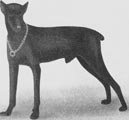 |
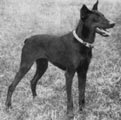 |
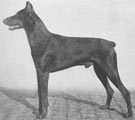 |
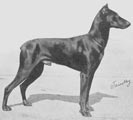 |
| 1915 Burschel v. Simmenau DZ 6328 |
1918 Lotte v. Simmenau DZ 40748 |
1918 Lux v.d. Blankenburg DZ 6560 |
1919 Prinz Carlo v.d. Koningstad DZ 9853 |
| 1915 | Burschel v. Simmenau (photo above at undeveloped age of 10 months of age) survived the horrors of WW1 and was largely responsible for restarting the Dobermann breed in Germany. Grünig says his temperament was sharp and Burschel was sold often - at least once due to his incurable viciousness. According to Grünig, Burschel's Ilm-Athen ancestry assured him great hereditary powers of transmission and his descendants proved that an individual dog of Burschel's stature, can be the redeemer of an entire breed. | |
| 1918 | Lotte v. Simmenau (photo above) had a very nice body and excellent character. She was trained as a police dog. Lux v.d. Blankenburg (photo above) was a famous stud and show dog and, according to Mr. Grünig, was overbred in Germany so that his numerous progeny ranged from miserable to excellent. Of his best were Alto v. Sigalsburg and Ari v. Sigalsburg. Fortunately Lux transmitted his virtues more than his faults. Lux had self confidence and sharpness but was also called "rowdy and vicious". After winning many prizes, including Sieger title, he was exported to the USA. | |
| 1919 | Prinz Carlo v.d. Koningstad (photo above) was from Dutch breeding. All the great sires of the early beginnings were found in his pedigree. A judge wrote he had faultless type with outstanding character. He had great hereditary power but was exported at an early age to become Stud/Champion in the USA. |
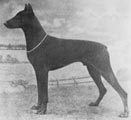 |
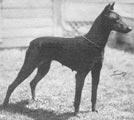 |
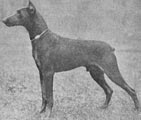 |
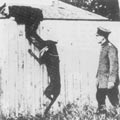 |
| 1920 Benno v.d. Römerhof DZ 12015 |
1920 Prinsessin Elfrieda v.d. Koningstad DZ 29878 |
1921 Prinz Favorit v.d. Koningstad DZ 24744 |
1922 Ajax v. Oderwald DZ 19366 |
| 1920 | This was the most productive year in the history of the breed. At this same time, many of Germany's best Dobermann began to be exported to other countries. Benno v.d. Römerhof (photo above) was bred in Holland. He was a large and powerful dog with good character but no famous progeny. He was sold at 5 years to the USA. Alex v.d. Finohoehe had the best pedigree conceivable and value to transmit but was largely unrecognised by most breeders. Grünig refers to him as a neglected "living gem" that was sold to Czechoslovakia and stabilized the breed there. Bitches with power to transmit their type were numerous this year and included: Dora v. Wiesengrund, Asta v. Stolzenburg, Blanka Halberstadt and Prinsessin Elfrieda v.d. Koningstad (photo above) was a small Dutch bitch who was outstanding in the show ring in the USA. | |
| 1921 | Prinz Favorit v. Koningstad (photo above) was a Dutch bred large, well built, brown male. (Prinz Modern v. Ilm-Athen and Marko v. Jägerhof appear 5 times in his pedigree but at least 4 generations back). He was a sire of vast and individual potency to the USA gene pool and died at almost 13 years of age. Claus v.d. Spee, rated the best black male, possessed great undauntedness and was very sharp. As a stud he was most successful in the USA. | |
| 1922 | Brought many good quality dogs, among them, German born Horst v. Stresow who became the modern Dobermann's pioneer in the Soviet Republic. Ajax v. Oderwald (photo above) was a nicely built, small, black male with a fiery character. He was sharp and a real fighter but with courage and hardness - qualities sadly missing in most of today's Dobermann. Grünig says Lotte v. Roeneckenstein (sired by Alex v.d. Finohoehe 1920 above) "was the best black bitch heretofore recorded with hereditary worth and value gleaming like a meteor in the night sky". She was dam to Lux II v. Simmenau, Lotte II v. Simmenau, Modern v. Simmenau, Mars v. Simmenau (photo below), Ari v. Sigalsburg (photo below) and Alto v. Sigalsburg (photo below). |
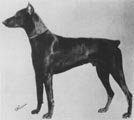 |
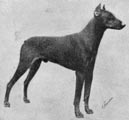 |
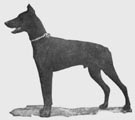 |
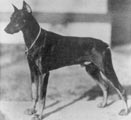 |
| 1923 Ari v. Sigalsburg DZ 23418 |
1923 Alto v. Sigalsburg DZ 23417 |
1927 Mars v. Simmenau DZ 45091 |
1929 Muck v. Brunia DZ 44392 |
| 1923 | Brought Alto v. Sigalsburg (photo above) and Ari v. Sigalsburg (photo above) a pair of brothers with elegance and substance and representative of a new style in the breed. Ari was best in form, Alto, who became German Sieger, was heavier with a nicer head. Grünig criticized only their shoulder position causing a "terrier gait", otherwise rating them faultless "marvels of compactness" with irrepressible courage and spirit. | |
| 1926 | This was a very fruitful year for the Dobermann. The best noted as Hamlet v. Herthasee and Lotte II v. Simmenau (daughter of Lotte v. Roeneckenstein). | |
| 1927 | Brought Mars v. Simmenau (photo above), a large black male of the best form and quality (but rarely in the show ring). Grünig says he was faithful to his master but the sharpest male he ever encountered - "A fighter of the greatest heart and courage, he feared no opponent and preferred to go down fighting rather than admit defeat." His progeny received his physical traits and courage. | |
| 1929 | Brought some good dogs including Eike zum Ziel, a black male whose character was as good as his form. Muck v. Brunia (photo above), (grandson to Alto v. Sigalsburg) became Sieger and later USA Champion (imported to improve character) and became one of the pillars on which the present breed is built. Muck can be found in almost all Dobermann pedigrees. |
Grünig's "History and development of the Dobermann Breed" ends around 1930.
The original Dobermann were often described as "robust, with no trace of fear - not of the devil himself - and it required a good deal of courage to own one of them." Subsequent selection (for conformation) has greatly diminished these qualities but hopefully the modern Dobermann should combine the fire and lightning reactions of the terrier with the power and intelligence of the guard and herding breeds.
The Dobermann was tailored for police and military work, and to be a medium sized protector-companion at home.
Note: After 1949 it was decided that the name "Pinscher" (meaning Terrier) after the word "Dobermann" was not appropriate and the breed was referred to simply as the Dobermann.
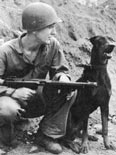 |
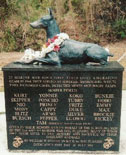 |
The Dobermann was the official combat dog of the U.S. Marine Corps in World War II. Often called "devil dogs", they served as sentries, messengers and scouts, facing full battle conditions with their handlers.
Left: Statue of "Kurt", a Dobermann who saved the lives of 250 U.S. Marines when he alerted them to Japanese soldiers (University of Tennessee's College of Veterinary Medicine).
Right: Dobermann Andy in Bougainville during WWII.